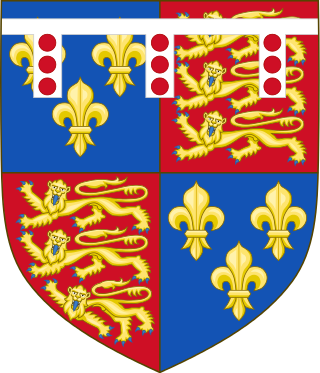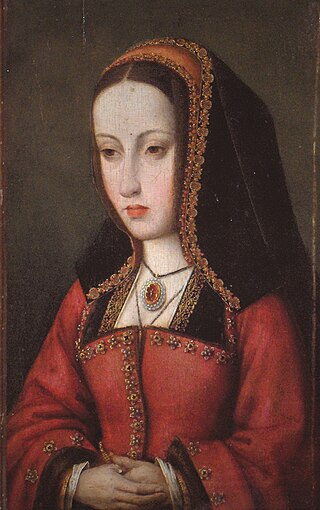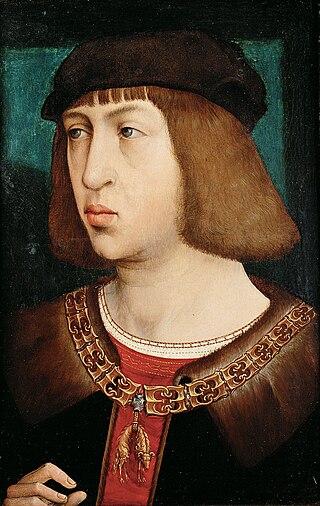
Henry VII was King of England and Lord of Ireland from his seizure of the crown on 22 August 1485 until his death in 1509. He was the first monarch of the House of Tudor.

Year 1506 (MDVI) was a common year starting on Thursday of the Julian calendar.
Year 1496 (MCDXCVI) was a leap year starting on Friday of the Julian calendar.

The House of York was a cadet branch of the English royal House of Plantagenet. Three of its members became kings of England in the late 15th century. The House of York descended in the male line from Edmund of Langley, 1st Duke of York, the fourth surviving son of Edward III. In time, it also represented Edward III's senior line, when an heir of York married the heiress-descendant of Lionel, Duke of Clarence, Edward III's second surviving son. It is based on these descents that they claimed the English crown. Compared with its rival, the House of Lancaster, it had a superior claim to the throne of England according to cognatic primogeniture, but an inferior claim according to agnatic primogeniture. The reign of this dynasty ended with the death of Richard III of England at the Battle of Bosworth Field in 1485. It became extinct in the male line with the death of Edward Plantagenet, 17th Earl of Warwick, in 1499.
Edmund de la Pole, 3rd Duke of Suffolk, 6th Earl of Suffolk, KG, Duke of Suffolk, was a son of John de la Pole, 2nd Duke of Suffolk and his wife Elizabeth of York.

Joanna, historically known as Joanna the Mad, was the nominal queen of Castile from 1504 and queen of Aragon from 1516 to her death in 1555. She was the daughter of Queen Isabella I of Castile and King Ferdinand II of Aragon. Joanna was married by arrangement to the Austrian archduke Philip the Handsome on 20 October 1496. Following the deaths of her elder brother John, elder sister Isabella, and nephew Miguel between 1497 and 1500, Joanna became the heir presumptive to the crowns of Castile and Aragon. When her mother died in 1504, she became queen of Castile. Her father proclaimed himself governor and administrator of Castile.

Philip the Handsome, also called the Fair, was ruler of the Burgundian Netherlands and titular Duke of Burgundy from 1482 to 1506, as well as the first Habsburg King of Castile for a brief time in 1506.
Duke of Burgundy was a title used by the rulers of the Duchy of Burgundy, from its establishment in 843 to its annexation by France in 1477, and later by members of the House of Habsburg, including Holy Roman emperors and kings of Spain, who claimed Burgundy proper and ruled the Burgundian Netherlands.

Isabella of Austria, also known as Elizabeth, was born an Archduchess of Austria and Infanta of Castile from the House of Habsburg, and subsequently became Queen of Denmark, Norway and Sweden, under the Kalmar Union, as the wife of King Christian II. She was the daughter of King Philip I and Queen Joanna of Castile and the sister of Charles V, Holy Roman Emperor. She ruled Denmark as regent in 1520.

Archduchess Margaret of Austria was Governor of the Habsburg Netherlands from 1507 to 1515 and again from 1519 to 1530. She was the first of many female regents in the Netherlands.
The count of Artois was the ruler over the County of Artois from the 9th century until the abolition of the countship by the French revolutionaries in 1790.

The House of Plantagenet was a royal house which originated in the French County of Anjou. The name Plantagenet is used by modern historians to identify four distinct royal houses: the Angevins, who were also Counts of Anjou; the main line of the Plantagenets following the loss of Anjou; and the houses of Lancaster and York, the Plantagenets' two cadet branches. The family held the English throne from 1154, with the accession of Henry II, until 1485, when Richard III died.
The Intercursus Magnus was a major and long-lasting commercial treaty signed in February 1496 by King Henry VII of England and Duke Philip IV of Burgundy. Other signatories included the commercial powers of Venice, Florence, the Netherlands, and the Hanseatic League.

The House of Valois-Burgundy, or the Younger House of Burgundy, was a noble French family deriving from the royal House of Valois. It is distinct from the Capetian House of Burgundy, descendants of King Robert II of France, though both houses stem from the Capetian dynasty. They ruled the Duchy of Burgundy from 1363 to 1482 and later came to rule vast lands including Artois, Flanders, Luxembourg, Hainault, the county palatine of Burgundy (Franche-Comté), and other lands through marriage, forming what is now known as the Burgundian State.

Habsburg Netherlands was the Renaissance period fiefs in the Low Countries held by the Holy Roman Empire's House of Habsburg. The rule began in 1482, when the last Valois-Burgundy ruler of the Netherlands, Mary, wife of Maximilian I of Austria, died. Their grandson, Emperor Charles V, was born in the Habsburg Netherlands and made Brussels one of his capitals.
Events from the 1490s in England.
Events from the 1500s in England.
Events from the year 1506 in England.

Ferdinand II was King of Aragon from 1479 until his death in 1516. As the husband of Queen Isabella I of Castile, he was also King of Castile from 1475 to 1504. He reigned jointly with Isabella over a dynastically unified Spain; together they are known as the Catholic Monarchs. Ferdinand is considered the de facto first king of Spain, and was described as such during his reign, even though, legally, Castile and Aragon remained two separate kingdoms until they were formally united by the Nueva Planta decrees issued between 1707 and 1716.

The Burgundian State is a concept coined by historians to describe the vast complex of territories that is also referred to as Valois Burgundy.











